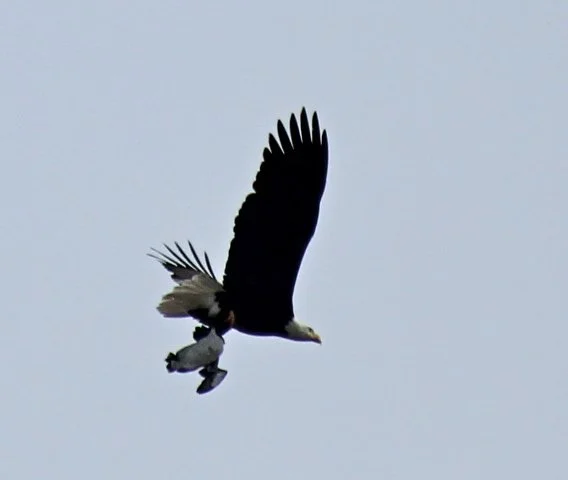Bald Eagle (Haliaeetus leucocephalus)
Adult bald eagle (photo credit: Molly Sultany)
Adult and juvenile bald eagles (photo credit: Molly Sultany)
Bald eagle with a common murre (photo credit: Susan Glarum)
Description: In the wild, bald eagles can live for up to 20-30 years. Adult male bald eagles reach about 90 cm tall, while the slightly larger adult females can reach 108 cm tall. They are named for their white head but while the white might make them look bald, the name actually comes from an old English word “balde” meaning white. The rest of their body is a dark brown color until their tail, which is white.
Habitats: Bald eagles inhabit North America from the north of Alaska and Canada down to the Mexico border. They live in forested areas near lakes and reservoirs with plenty of fish to eat. They also live in the forested areas near coastlines similar to the Cannon Beach area directly east of Haystack Rock.
Nesting: There are several bald eagle nests near Haystack Rock. Bald eagles lay 2 (sometimes 1 or 3) white, nearly spherical eggs. Both parents incubate the eggs for 34 to 36 days. After the chicks hatch, parents bring food to the nest for 10 to 12 weeks, until the fledglings take their first flights. At Haystack Rock, bald eagle sightings are common in the late spring and early summer, presumably due to an increased need for prey to feed their chicks.
Diet: Bald eagles consume both coastal and freshwater species of fish. Along our Pacific Coast, bald eagles tend to eat salmon and trout. They’re also known for eating other seabirds and waterfowl and can be seen preying on the birds living on Haystack Rock in Cannon Beach. When looking for a snack off the rock, they often go for common murres.
Tide Pool Tidbits:
Bald eagles are kleptoparasites: they are often found harassing other birds of prey until the other bird drops its catch so the bald eagle can steal it. Bald eagles have also been observed snatching the prey of other birds right out of their talons. These bold birds will also steal fish from mammals including humans that are fishing!
Bald eagles have been observed playing with objects such as plastic bottles or sticks, sometimes passing the objects from one bald eagle to another as they fly in groups.
Juvenile bald eagles lack the “bald” plumage of the adult; they instead have a more mottled plumage containing a mix of brown and white feathers. Because of this different appearance, juvenile bald eagles are often confused for adult golden eagles.
References: The Cornell Lab, Audubon




